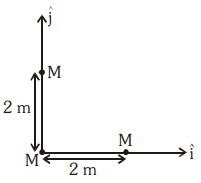A uniform square plate \(ABCD\) has a mass of \(10\) kg.
If two point masses of \(5\) kg each are placed at the corners \(C\) and \(D\) as shown in the adjoining figure, then the centre of mass shifts to the mid-point of:
1. \(OH\)
2. \(DH\)
3. \(OG\)
4. \(OF\)
The mass per unit length of a non-uniform rod of length \(L\) is given by \(\mu =λx^{2}\) where \(\lambda\) is a constant and \(x\) is the distance from one end of the rod.
The distance between the centre of mass of the rod and this end is:
1. \(\frac{L}{2}\)
2. \(\frac{L}{4}\)
3. \(\frac{3L}{4}\)
4. \(\frac{L}{3}\)
The centre of the mass of \(3\) particles, \(10\) kg, \(20\) kg, and \(30\) kg, is at \((0,0,0)\). Where should a particle with a mass of \(40\) kg be placed so that its combined centre of mass is \((3,3,3)\)?
1. \((0,0,0)\)
2. \((7.5, 7.5, 7.5)\)
3. \((1,2,3)\)
4. \((4,4,4)\)
Five uniform circular plates, each of diameter \(D\) and mass \(m\), are laid out as shown in the figure. Using the origin shown, the \(y\text-\text{coordinate}\) of the centre of mass of the ''five–plate'' system will be:

| 1. | \(\frac{2D}{5}\) | 2. | \(\frac{4D}{5}\) |
| 3. | \(\frac{D}{3}\) | 4. | \(\frac{D}{5}\) |
| 1. | \(9.9\) m | 2. | \(10.1\) m |
| 3. | \(10\) m | 4. | \(20\) m |
At \(t=0\), the positions of the two blocks are shown. There is no external force acting on the system. Find the coordinates of the center of mass of the system at \(t=3\) seconds:
| 1. | \((1,0)\) | 2. | \((3,0)\) |
| 3. | \((4.5,0)\) | 4. | \((2.25,0)\) |
Three identical spheres, each of mass \(M\), are placed at the corners of a right-angle triangle with mutually perpendicular sides equal to \(2~\text{m}\) (see figure). Taking the point of intersection of the two mutually perpendicular sides as the origin, find the position vector of the centre of mass.

| 1. | \(2( \hat{i}+ \hat{j})\) | 2. | \(( \hat{i}+ \hat{j})\) |
| 3. | \({2 \over 3}( \hat{i}+ \hat{j})\) | 4. | \({4 \over 3}( \hat{i}+ \hat{j})\) |
| 1. | zero | 2. | \(1\) m |
| 3. | \(2\) m | 4. | \(5\) m |
A wheel has an angular acceleration of \(3.0\) rad/s2 and an initial angular speed of \(2.00\) rad/s. In a time of \(2\) s,
it has rotated through an angle (in radian) of:
1. \(6\)
2. \(10\)
3. \(12\)
4. \(4\)
If a body is moving in a circular path with decreasing speed, then: (symbols have their usual meanings):
1.
2.
3.
4. All of these




